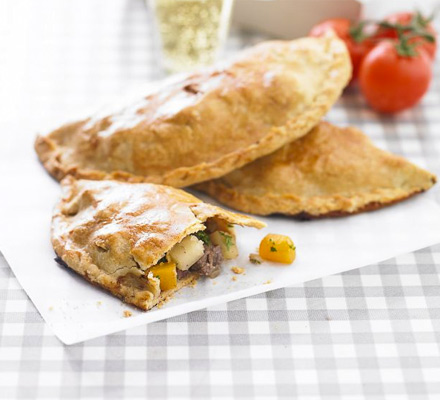Lighter Cornish pasties
Angela Nilsen retains the taste but halves the fat of these traditional pastry bakes by using beef skirt and less butter in the pastry
-
Prep:1 mins
Cook:50 mins
- More effort
Nutrition per serving
-
kcal 511
-
fat 25.2g
-
saturates 10.7g
-
carbs 48.5g
-
sugars 3.1g
-
fibre 2.8g
-
protein 22.1g
-
salt 0.8g
Ingredients
- 400g beef skirt, excess fat trimmed, cut into small chunks
- 140g potatoes, diced
- 140g/5oz swede, diced
- 100g/4oz onion, finely chopped
- 3 tbsp chopped parsley
- 1 tbsp Worcestershire sauce
- 350g plain flour, plus extra for dusting
- 1¼ tsp baking powder
- 85g cold butter, cut into small pieces
- 3 tbsp extra virgin rapeseed oil
- 1 large egg, separated
Method
To make the filling, mix everything together in a bowl with ¾ tsp black pepper and 1 tbsp cold water. Stir in a pinch of salt and set aside. Heat oven to 200C/180C fan/gas 6. Line 1-2 baking sheets or trays with baking parchment.
To make the pastry, put the flour, baking powder and butter in a food processor. Pulse until the mixture resembles fine breadcrumbs. Tip in the oil, egg yolk and 5 tbsp cold water. Pulse again until the dough just starts to come together, adding another ½-1 tbsp water, or as needed. If you gently press the dough and it sticks together, you know it’s the right consistency. Tip out the dough onto the work surface and gently press it into a smooth ball.
Cut the pastry into 6 equal pieces. For each pasty, lightly and briefly shape one piece of the pastry to a smooth ball. (Keep the other pieces wrapped in cling film until needed.) Press the ball down to make an even flattened round. Then roll the pastry out on a lightly floured surface, as thinly as you can, to a circle just over 20cm in diameter, keeping the round shape with your hands as you roll. As you’re rolling the pastry thinner than usual, handle it carefully to prevent it breaking, and keep the work surface and rolling pin lightly dusted with flour to prevent the pastry sticking. Use the base of a 20cm loose-bottomed cake tin (or similar) as a guide to cut around to neaten the pastry edges (step 1). Spoon a sixth of the filling down the centre of the pastry circle and lightly press down with your hand to contain and flatten it slightly. Dampen the pastry edges with water (step 2) and carefully bring one side of the pastry over to join the other side (step 3), tucking in the filling to keep it inside as you do so. Press the joins together to seal, then make a thin decorative edge by rolling or curling the pastry edge over all the way around. Press down to seal. Repeat with the remaining pastry and filling. Sit each pasty on the baking sheet or tray, then pierce a small hole in the top of each one for the steam to escape. Beat the egg white to loosen, then brush a little over each pasty to glaze (step 4).
Bake for 15 mins, then lower the oven to 180C/160C fan/gas 4. Brush with more egg white, and bake a further 35 mins until the pastry is crisp and golden, covering loosely with foil if they are browning too quickly. Remove with a wide spatula and leave to cool slightly on a wire rack. Serve warm or cold.





















